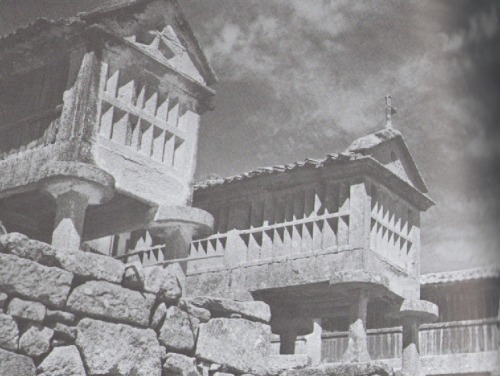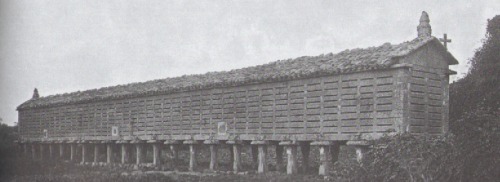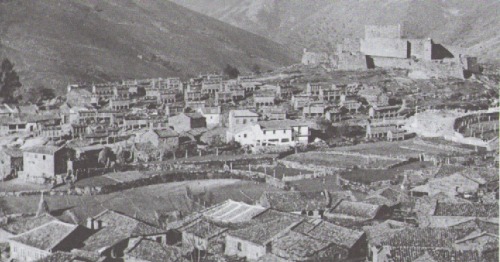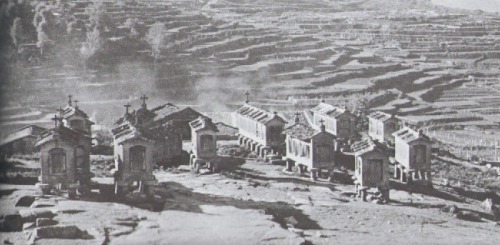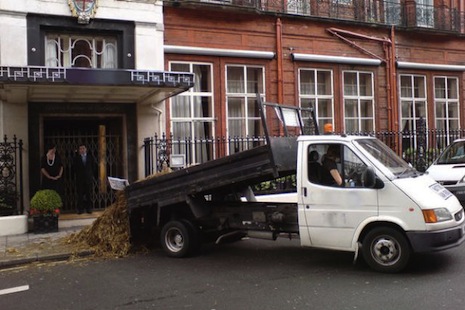
Here’s a neat image of a record and a stylus at 1000x magnification. It’s pretty incredible to see the etched grooves on the record up close and how they interact with the needle. I’ve always known how record players worked, but seeing the process magnified like this is way cool.
diogofalmeida
Shared posts
Vinyl and stylus at 1000x magnification
b-a-c-u: Public utilities building for telephone and postal...

Public utilities building for telephone and postal services,
Cluj-Napoca, Romania,
built between 1966-69,
Architect Vasile Mitrea
Ghost Stadium: Inside Michigan’s Abandoned Pontiac Silverdome
 (All images by Brandon Davis, reproduced with permission)
(All images by Brandon Davis, reproduced with permission)
When it comes to abandoned stadiums, they don’t come much more impressive than the metropolitan Detroit’s iconic Silverdome. Originally named the Pontiac Silverdome after the Michigan city in which it stands, the vast stadium occupies 127 acres and was the largest in the National Football League (NFL) until the opening of Washington D.C.’s FedEx Field in 1997. But with the move of its main tenant – the Detroit Lions – to Ford Field in 2002 came a period of decline that culminated in the abandoned stadium’s eventual sale. Today, the Detroit Silverdome remains empty, its storied seats and other memorabilia auctioned off as the vast, cavernous shell awaits its ultimate fate.
Silverdome History

The Silverdome was the brainchild of former Pontiac high school athlete C. Don Davidson, who spearheaded an era of urban redevelopment in his home town after earning a masters of architecture degree from North Carolina State University. When the stadium opened in August 1975, it formed the centerpiece of Davidson’s vision for a reinvigorated Pontiac.
The Silverdome took its famous name from the Teflon-coated fibreglass roof, which though appearing white to the naked eye, often took on a brilliant silver sheen when viewed from above due to the reflection of the sun. But damage to the original roof during the 1984-1985 season, which necessitated its replacement with a new canvas canopy, led one resident sports team, the Detroit Pistons, to move elsewhere.

Two years later brought WrestleMania III when the Silverdome played host to its largest ever crowd of 93,173 people. During its heyday the stadium also hosted rock bands such as Led Zeppelin, The Who, Elvis Presley and Bruce Springsteen.
But when the Lions moved to Ford Field in 2002, the Silverdome’s fortunes began to wane. The space was used for various offbeat purposes, from a meeting place for Jehovah’s Witnesses to a drive-in movie theatre. Eventually, ongoing financial woes led to its sale in 2006.

The end, however, was not yet nigh. The abandoned stadium reopened in April 2010 to host a monster truck extravaganza. The new owner, meanwhile, told the Detroit Free Press that he planned to invest millions of dollars in the venue’s future.
The Silverdome Today
But the stay of execution appears to have been short-lived. Despite the possibility to reuse the Silverdome as a Major League Soccer (MLS) stadium, March 2014 saw the owners auction its contents to the public. Seats were sold for $100 a piece (owners to collect) and today, the historic facility stands eerily silent.

The iconic roof has collapsed and wind whistles through the empty concourses. It’s a far cry from the 82,000 seater stadium envisioned by C. Don Davidson, now more a tragic reflection of Detroit’s decline than hallowed sporting turf.
Keep Reading – Visit More Abandoned Stadiums Around the World
The post Ghost Stadium: Inside Michigan’s Abandoned Pontiac Silverdome appeared first on Urban Ghosts.
Unimpressed man calmly sits in restaurant while it’s invaded by masked gang
diogofalmeidarussia <3

There’s not too much information about this video which surfaced on the Internet yesterday of an unimpressed man sitting in a restaurant while 35 armed and masked men invade the place. The whole thing went down somewhere in Russia.
“Couldn’t Care Less Guy” just calmly sits there, casually sipping...
Shit Record Covers
diogofalmeidastill surprising

Whenever I see a gallery of crappy album covers, I get annoyed because it’s always the same ones—By Request Only - Ken, Julie’s Sixteenth Birthday - John Bult,
Punk legends give us a rare insight into their cherished vinyl collections
Punk legends give us a rare insight into their cherished vinyl collections.
Upcoming documentary Records Collecting Dust showcases the vinyl collections of alternative music icons. The film includes interviews with former Dead Kennedys frontman Jello Biafra and Black Flag’s Keith Morris and Chuck Dukowski as well as 30 of their peers. The film also features live performances from Biafra and The Locust.
Records Collecting Dust was created by Jason Blackmore, who explained, “I wanted to capture the pre-internet world of finding your new favorite band and record. Before the internet, you didn’t have blogs, Spotify, and YouTube to find new music. You went to your local record shop and many times purchased a record because you liked the cover art. I also hoped to capture the intimacy of sitting down in these people’s living rooms and talking about the records and bands that influenced them. For many of the people featured in our film, it’s not just the music that played a major influence — it’s the process in which they discovered it.”
Watch the trailer below.
balkanblues: Portraits of Rural Albania The “Moving Albania”...









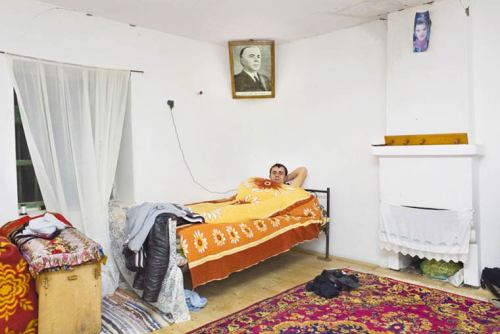
Portraits of Rural Albania
The “Moving Albania” series by Belgian photographer Frederik Buyckx, based in Antwerp, who on a trip captured without artifice images of everyday life in rural Albania.
Studio 54 Still Looks Like the Best Club Ever
Roots of ‘The Evil Dead’ franchise: Watch Sam Raimi’s 1978 short film, ‘Clockwork’

Sam Raimi would have been no more than 19 years old when he directed Clockwork, but you can definitely see the horror-legend’s talents gestating in the bones of this little Super-8 thriller. Scott Spiegel, the writer, director, producer and actor who would...
Someone Stole and Wrecked a TRAIN near Moscow
 Ok, now for some weird news. It was reported last night that someone sneaked into a train station in Lobnya, a town near Moscow, and… stole a train. Then he (or a group of people) rode this train on the … Read more...
Ok, now for some weird news. It was reported last night that someone sneaked into a train station in Lobnya, a town near Moscow, and… stole a train. Then he (or a group of people) rode this train on the … Read more...
Potty-mouthed Princesses: Which is more offensive: Sexism or little girls saying ‘f*ck’?
diogofalmeidaPrejudice as a business opportunity.

As far as ethical consumerism goes, FCKH8 is pretty unobjectionable to non-bigots. For a reasonable price, you get a T-shirts with an antisexist, anti-racist or anti-homophobic slogan on it—what the company calls a “mini-billboard...
Yo, you remember this ad, right? "Aaron Burr! Aaaaaaron Burr!?...
diogofalmeidaConfesso que não sabia.
Yo, you remember this ad, right?
"Aaron Burr! Aaaaaaron Burr!? AARON BURR!"
Classic “Got Milk” ad, right?
But wait.
I just learned a fact about this ad that is going to bother you.
I’m going to tell you what it is.
But be warned.
It’ll really upset you.
Okay, you ready?
You know who directed it?
(You’re going to be upset when you find out.)
This classic “Got Milk” ad
Was directed by …
.
.
.
Michael Bay.
Sorry for ruining your day.
Not So Great Estates: 10 Beautiful Lost Country Houses of England

A changing political climate, a massive economic shift, world wars, curses and ghosts…. the reasons are often complicated, but no less sad. At one time, the magnificent country house was a staple of English nobility and economic power; beautifully breathtaking and equally impractical, the country home was a symbol of a noble class that could afford not only the home but a small army of servants to tend to their every need. Since the coming of the 20th century, though, it’s estimated that 1 in every 6 has been leveled for one reason or another, leading to a mass extinction of these stately manors, which left behind ruined families, empty land, and, in some cases, motorways.
10. Derwent Hall, Derbyshire
 (Images: Alfred J. Gotch, public domain; Tim Hallam, cc-sa-4.0)
(Images: Alfred J. Gotch, public domain; Tim Hallam, cc-sa-4.0)
Derwent Hall was originally built in 1672 as the family seat of Henry Balguy of The Hagg. It went through several incarnations, serving first as the family mansion, then a farmhouse, and finally a youth hostel in 1931.
During World War II, the house became something of an impromptu school and shelter for children moved from the nearby city of Sheffield to the safety of a country house. Knowing that the city was living under a near perpetual threat of bombing, a number of families decided to send their children away. For some, that meant going overseas but for many, that meant retreating to the countryside. By the time Derwent Hall found itself home to a number of area children, the construction that would ultimately lead to its downfall was already under way.
The valley where the country home once stood was flooded in 1945, creating the Ladybower reservoir out of a necessity to supply fresh water to Sheffield and Derby. The house – and the village that surrounded it – was almost completely demolished, its remains lying at the bottom of the reservoir. During months when the water level falls, the ruined foundations of the old manor and the homes that once surrounded it can still be seen.
9. Beaudesert, Staffordshire
 (Images: Morris, public domain; Bs0u10e01, cc-3.0)
(Images: Morris, public domain; Bs0u10e01, cc-3.0)
The land that the present-day ruins of Beaudesert stand on were once home to a Cistercian monastery in the 1100s, then functioned as a hunting lodge and retreat for area bishops. During the reign of Henry VIII, the land was given to his Secretary of State and the original house was built.
Expanded and modified over the years, Beaudesert went through a series of upgrades until it was severely damaged by a fire that broke out in 1909. At this time, the home’s owner, the 6th Marquess of Anglesey, was still in a financial position to gut the interior of the home, remove the extensive fire damage, and do a complete restoration of the home. It wasn’t long after, though, that there were a series of massive taxes placed on the house and the property that the Marquess – once the 3rd richest man in England – could no longer afford. Manuy of the interior furnishings of the home were sold in 1919, and the estate itself was auctioned off to a development company in 1935, seeming to seal its fate.
Demolition on the house was begun, but never finished as the development firm ran out of money before they could complete it. Now, ruins belonging to the once-majestic country house can still be seen on the grounds, which – unlike a number of country homes now buried by office blocks and motorways – have retained their wild beauty. In 1937, Angelsey donated a good portion of the estate to a wildlife trust, and it’s now used for scouting trips.
8. Costessey Hall, Norfolk
 (Image: via Wikipedia, public domain)
(Image: via Wikipedia, public domain)
Costessey Hall was something of an oddity among the great country houses; while many were elegant Tudor or Victorian creations, Costessey Hall was more of a medieval fairytale castle. Described in some cases as something of a folly, the hall’s later renovations included a series of turrets and towers, ornate chimneys and rather fanciful Gothic architecture – quite a difference from the original house given to the Earl of Richmond by William the Conqueror in 1066.
In its day, Costessey Hall was known as being one of the most theatrical of the old country homes, with new additions that all but smothered the original buildings in their ornate elegance. The majority of the most extravagant work was done through the late 18th and early 19th century, with the 1913 death of the last Lord Stafford Jerningham ending a family legacy that had begun with the awarding of the estate to Sir Henry Jenegan by Queen Mary in 1555.
After his death, most of the estate’s belongings were auctioned off and the manor was taken over by the War Office for use during World War I. It became home to several regiments of cavalry, infantry and artillery, but there were no procedures set in place to deal with the enormous amount of wear and tear subjected to the manor and its grounds by the presence of military units. While some of the stonework and fireplaces were salvaged for use in other homes, the majority of the building was deemed to far damaged to be worth saving, and was destroyed in 1918.
7. Thorington Hall, Suffolk
 (Images: Lost Heritage)
(Images: Lost Heritage)
At a glance, Thorington Hall seems an unlikely house to meet the same fate as many of the larger, insanely expensive, grandiose country homes once belonging to England’s rich and powerful. A relatively small – and manageable – 876 acres, the country house was originally built in 1819 by the Bence family, who had made their fortune in trading.
The home was passed on through the family to the granddaughter of the original owner, who was unable to have children of her own after a riding accident. With no family left to inherit the home, it was occupied by the Army in 1940; stories differ on just what happened to the home while it was in the care of the military, with some accounts saying that the paneling was used for firewood and and much of the home falling victim to extensive, rough mistreatment – while other accounts say that the house survived its military occupation largely intact and unscathed.
From the inside, at least – the estate was hit by several bombs during the war. They left the house itself undamaged, but with the last Bence heir unwilling to move back into the house at her elderly age and no one left to inherit the home, it was put up for sale.
No one wanted it. Not as a home, at least, and it was ultimately sold to a firm for salvage and demolition after 300 years of acting as a beloved family estate.
6. Southcote House, Berkshire
 (Images: Reading Library via Royal Berkshire History; Des Blenkinsopp, cc-sa-4.0)
(Images: Reading Library via Royal Berkshire History; Des Blenkinsopp, cc-sa-4.0)
Southcote House began its long life as part of a fortified manor house, and was heavily rebuilt and modified in the 17th century. It became Southcote Lodge when it was bought by Anthony Blagrave and was ultimately handed down through his family, where it picked up its reputed ghost.
The country house was home to Daniel Blagrave, who gained a certain amount of notoriety by signing the death warrant of Charles I. The house was briefly used as planning chambers for Cromwell and the Earl of Essex, and it’s not surprising that it’s this period in the beautiful estate’s long history that is remembered in local ghost stories.
According to the story, there was some debate about whether or not the house was supposed to pass to Daniel. Servants who whisper amongst themselves that there was something a little dodgy about the inheritance of the house were likely to meet the ghost of Daniel, insisting that the house – and everything in it – was rightfully his. The ghost wasn’t above telling them to get out, either, so that those who have the right to be there can enjoy the home.
Southcote underwent another update, keeping in in line with the more Victorian tastes and styles. By the early 20th century, though, the house began to fall into neglected ruins. It was demolished in 1921, but the last remains of it – the gatehouse – stood until the 1960s.
5. Clumber House, Nottinghamshire
 (Images: GBC Mag; Google Earth)
(Images: GBC Mag; Google Earth)
The history of Clumber House is so ancient that it’s largely been lost. It’s mentioned in the Domesday Book, when it’s described as a Middle Ages monastic settlement. Established as a park and estate in the 1700s, it became first a hunting estate then, finally, a proper manor house was added in around 1760, with more elegant additions being tacked onto the original lodge.
Sitting on 3,800 acres, Clumber House was home to not only an elegant manor and gardens, but priceless works of art. It once housed Rembrandts and Rubens, along with some first editions of Shakespeare. Many of the works were tragically lost in a fire that swept through the estate in 1879, and the present owners (who were holding the house in trust for the next heir), decided to spend the small fortune needed to rebuild the home.
Sadly, the owner for which the home was rebuilt – the 7th Duke of Newcastle – wasn’t really interested in the home and spent little time there. Fire ravaged the house again in 1912, and the family was faced with the decision of not only sinking more money into the home to rebuild, but also to continue paying the staggering amount of taxes on the property, which wasn’t being used much anyway. Deciding that the house was no longer worth the upkeep, it was slated for demolition.
The owners, though, wanted it to be known that it wasn’t being demolished because they truly wanted to be rid of the house, but because the taxes that were being imposed on them left them with no choice. Ultimately leveled in 1938, a number of rumors sprang up around the “real” fate of the house, including one that suggested it had been not actually demolished, but dismantled, brick by brick, and moved to Arizona.
4. Deepdene, Surrey
 (Images: Nooks, Towers & Turrets; Rib, cc-sa-4.0)
(Images: Nooks, Towers & Turrets; Rib, cc-sa-4.0)
Dating back to the mid-17th century, Deepdene was once famous not only because of its massive stately manor, but because of its immaculate ornamental gardens. Early in its life it was the summer home for the 10th Duke of Norfolk, and was eventually bought by the Hope family in 1808. They added conservatories, libraries and massive galleries, and, as one of the richest families in England at the time, they used to to store and showcase treasures from around the world. From art to antiquities, Deepdene was once part home, part museum.
Near the turn of the 20th century, the home became the property of the Duke of Newcastle and residence of the dowager Duchess of Marlborough, who frequently received her nephew, Winston Churchill, there.
The once-beautiful estate’s fate was a sad one. The grounds were divided in 1920, when some were used for housing developments. The house itself was turned into a hotel, losing much of its charm when a bypass was built through the gardens that had once been its trademark. The hotel became the home of Southern Railway, and it was ultimately leveled in 1967. Now, an office block sits on the grounds.
3. Pyrgo Park, Essex
 (Images: Lost Heritage; Volatile66, cc-sa-3.0)
(Images: Lost Heritage; Volatile66, cc-sa-3.0)
Pyrgo Park began as a hunting lodge dating back to the Saxon era; it was a popular retreat for names like Edward the Confessor and Charles II. Originally referring to the entire estate rather than just the county house, Pyrgo Park sprawled across the edge of Havering and eventually joining the Royal Palace of Havering, once residence of Catherine of Aragon and later Ann Boleyn.
Perhaps its most important part to play in England’s history was a reunion between Henry VIII and his two daughters. Henry hadn’t seen much of Elizabeth and Mary, and in 1542, he met with them at Pyrgo Park. Before their meeting, Elizabeth and Mary weren’t officially part of the royal succession – the meeting at the manor house had such an impact on Henry and his daughters impressed him so that the future of England was changed – and his daughters were officially made part of the royal succession.
The house itself went through a number of different owners; its grounds were continuously expanded as families bought up more and more of the land around the house. By 1800, the estate contained 460 acres, and by 1880, it was closer to 600. It was about that time that a major depression hit the landscape and the families whose country homes dotted it. In 1921, owner Lord O’Hagan started selling off the property bit by bit and in 1935, the final land was sold to a development firm. Two years later, the Essex city council bought the property as part of their initiative to curb the sprawling spread of London. The house itself was leveled sometime between 1938 and 1940.
2. Witley Park, Surrey
 (Images: Via Daily Mail; cybergibbons)
(Images: Via Daily Mail; cybergibbons)
The Witley Park estate dates back to well before the Norman Conquest, but the country home as was ultimately demolished in 1952 has its beginning in 1890. After a string of tenants and owners, Whitaker Wright purchased the estate in 1890. A self-made millionaire, Wright would earn – and lose – several fortunes over the course of his lifetime, and one of these fortunes would be used to build Witley Park.
Not content to just build himself a country home, Wright was also determined to shape the landscape around him to suit his needs. Hills were leveled, lakes were dug, and included in the shaping of the land was the construction of a bizarre underwater billiard room – one of the few structures that still exists.
By 1900, Wright’s business endeavors began to fail. He’d sunk most of his fortune into creating his paradise on earth, and in 1904, he was put on trial for fraud. After being found guilty and sentenced to seven years in prison, he requested a private meeting with his lawyers…. during which he took a cyanide capsule and committed suicide rather than go to jail.
The estate was sold off in pieces, with large sections going to the town. The later owners of the manor house sold many of its contents, a slow demise that was considerably speeding along by a fire in 1952. The cause of the fire was never determined, but it led to the final demolition of the main house, although outlying buildings remained and today, the stable exists as a conference center.
1. Milner Field, Yorkshire
 (Images: via Telegraph & Argus; Rich Tea, cc-sa-4.0)
(Images: via Telegraph & Argus; Rich Tea, cc-sa-4.0)
With some of the grand country houses dating back centuries upon centuries, Milner Field is a relatively young estate with a brutally short existence. The house was built in 1869 as a testament to the success of its young businessman and philanthropist owner, Titus Salt. Salt had started out in the wool business, and he’d built an empire. Part of the driving desire behind the construction of Milner Field was a selfless one – Salt had always been horrified at the working and living conditions that so many were forced into, and decided that he was going to build not only a country home, but also a mill and village. Soon, Milner Field was simply the estate house near the large village of Saltaire.
Unfortunately, Milner Field was plagued by more than just taxes and high costs – it was plagued by misfortune.
Salt died in 1876, and his son, Titus Jr., took over the business and the home. Business began to fail with the changing times, though, and Jr, who had already been diagnosed with a weak heart, died in 1887. The house and its surroundings were then sold to man named James Roberts, who had even more misfortune befall his family.
One of his son succumbed to pneumonia, another drowned while on holiday, another died from complications of a “nervous illness”. His fourth son suffered major injuries during World War I, and was never able to work. He had no better luck with his daughter, who eloped to marry a man against her father’s will, later asking her husband for a divorce so she could marry his friend, who had long been her lover. Her husband shot and killed his rival, spending 10 years in Broadmoor and bringing the shadow of scandal over the family.
The next family in residence at the house also suffered a series of deaths, and the home’s final owner had the rather ignominious end of hiccuping himself to death because of a gall bladder and diaphragm condition. Unsurprisingly, the cursed home was getting harder and harder to sell, and eventually it was simply gutted for re-purposed materials. The final demolition took place in the 1950s, and now, there are only a few traces of the abandoned mansion left, including lonely piles of bricks and part of the mosaic tile floors.
The post Not So Great Estates: 10 Beautiful Lost Country Houses of England appeared first on Urban Ghosts.
Sugar skulls of the dead: Dia de los Muertos portraits of Blondie, the Ramones, Lemmy and more

Blondie Parallel Lines sugar skull album cover
Leisha Ganbatte is an illustrator and graphic designer based in Barcelona, Spain who enjoys creating sugar skull versions of punks like Blondie and the Ramones....
Soul Jazz to release 12”x12” book celebrating the art of disco sleeves, plus free fold-out coke mirror
diogofalmeida<3 Tenho o do punk, é incrivel

Career cratediggers at Soul Jazz have never been interested in ending their excitement at a beautiful reissue or anthology. Their thirst for knowledge pans out through well-researched liner notes, archaeological art, and even the book form. Essentially, they dig through crates so you don’t have to.
If print media is still your thing, then get excited: FACT reports that Disco will be given the bound treatment next. Much like Soul Jazz’s recent edition Punk 45: The Singles Cover Art of Punk 1976-1980, the new book definitely judges the records on their covers. Disco: An Encyclopedic Guide to the Cover Art of Disco Records contains over 2000 covers and 700 disco sleeves. The book itself is 12”x12”, allowing many of these pieces to be transmitted life-size.
Disco was edited by actual person Disco Patrick, author of The Bootleg Guide to Disco, and Patrick Vogt. DJ Tom Moulton wrote the introduction, and interviews include Mel Cheren (West End Records), Henry Stone (TK Records), Ken Cayre (Salsoul), Marvin Schlachter (Prelude), and Tom Moulton. Other ephemera includes historical information, full discographies, roller disco sleeves, and a scrapbook of disco ads.
While waiting for the November 3 release date, enjoy some Bumblebee Unlimited below:
• Soul Jazz: http://www.souljazzrecords.co.uk

